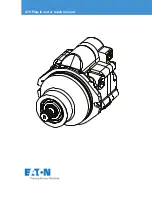
Marine Installation Manual
2021-08
2-2
2 Engine Power and Speed
2.3 Influence of propeller diameter and revolutions
X72DF
The rating field serves to determine the specific fuel and fuel gas consumption,
exhaust gas flow and temperature, fuel injection parameters, turbocharger and
scavenge air cooler specifications at the selected rating.
Percentage values
The engine speed is given on the horizontal axis and the engine power on the ver
-
tical axis of the rating field. Both are expressed as a percentage [%] of the respec
-
tive engine’s nominal R1 parameters. Percentage values are used so that the
same diagram can be applied to various engine arrangements.
Rating points
The rating points (R1, R2, R3, R4) for WinGD engines are the corner points of
the engine rating field (see
). The rating field is limited by two
constant Mean Effective Pressure (MEP) lines R1
—
R3 and R2
—
R4 and by two
constant engine speed lines R1
—
R2 and R3
—
R4.
The point R1 represents the nominal Maximum Continuous Rating (MCR). It is
the maximum power/speed combination which is available for a particular en
-
gine.
Any rating point (Rx) can be selected within the entire rating field to meet the re
-
quirements of each specific project. Such rating points require specific engine ad
-
aptations.
2.3
Influence of propeller diameter and revolutions
Influence of propeller
revolutions on the power
requirement
At constant ship speed and for a given propeller type, a lower propeller speed
combined with a larger propeller diameter increases the total propulsive effi
-
ciency. Less power is required to propel the vessel at a given speed.
The relative change of required power as a function of the propeller revolutions
can be approximated by the following relation:
Formula 2
-
1
where:
PX
j
............ = propulsive power for propeller revolution
n
j
n
j
............... = propeller speed corresponding with propulsive power
PX
j
α
............... = 0.15 for tankers and general cargo ships up to 10,000dwt, or
= 0.20 for tankers and bulk carriers from 10,000 to 30,000dwt, or
= 0.25 for tankers and bulk carriers larger than 30,000dwt, or
= 0.17 for reefers and container ships up to 3,000 TEU, or
= 0.22 for container ships larger than 3,000 TEU
This relation is used in the engine selection process to compare different engine
alternatives and to select an optimum propeller speed within the selected engine
rating field. Usually, the number of revolutions depends on the maximum per
-
missible propeller diameter.
2
2
1
1
PX
n
PX
n
a
æ
ö÷
ç
÷
ç
=
÷
ç
÷÷
çè ø
















































